
LMT035KDH03-NHA-1
LCD Module User Manual
Prepared by:
Checked by:
Approved by:
Luo Lin
Date: 2019-09-26
Date:
Date:
Rev. Descriptions
Release Date
0.1
New release
2019-09-25
URL: www.topwaydisplay.com
Document Name: LMT035KDH03-NHA-1-Manual-Rev0.1
www.topwaysz.com
Page: 1 of 15

TOPWAY
LCD Module User Manual
LMT035KDH03-NHA-1
Table of Content
1. General Specification ............................................................................................................ 3
2. Block Diagram ........................................................................................................................ 3
2.1
Terminal Functions ............................................................................................................... 4
3. Absolute Maximum Ratings .................................................................................................. 4
4. Electrical Characteristics ...................................................................................................... 5
4.1
DC Characteristics ............................................................................................................... 5
4.2
AC Characteristics ................................................................................................................ 5
4.2.1
8080 Mode Timing ....................................................................................................... 5
4.2.2
SPI Mode Timing ......................................................................................................... 6
4.2.3
Reset Timing ............................................................................................................... 8
5. Optical Characteristics .......................................................................................................... 9
6. Function Specifications ....................................................................................................... 11
6.1
Command Summary .......................................................................................................... 11
7. LCD Module Design and Handling Precautions ................................................................. 14
8. CTP Mounting Instructions ................................................................................................. 15
9. RTP Mounting Instructions ................................................................................................. 16
URL: www.topwaydisplay.com
Document Name: LMT035KDH03-NHA-1-Manual-Rev0.1
www.topwaysz.com
Page: 2 of 15

TOPWAY
LCD Module User Manual
LMT035KDH03-NHA-1
1. General Specification
Screen Size(Diagonal) :
3.5 inch
Resolution :
320(RGB) x 240
Interface :
8bit MCU Interface / SPI Interface
Color Depth :
16.7M color (24bit)
Dot Pitch :
0.219 x 0.219 (mm)
Pixel Configuration :
RGB Stripe
Display Mode :
Transmissive / Positive
Surface Treatment :
Anti-Glare Treatment
Viewing Direction :
6 o’clock
Outline Dimension :
92.7 x 72.0 x 10.9 (mm)
Active Area :
70.08 x 52.56 (mm)
Weight :
Approx 68g
Backlight :
LED, White
Operating Temperature :
-20 ~ +70°C
Storage Temperature :
-30 ~ +80°C
Note: Backlight color may slightly change over temperature and driving voltage.
2. Block Diagram
K1
/TP_SS
TP_SCLK
AD7843
Touch Panel
TP_MOSI
Touch Controller
TP_MISO
PENIRQ
Driver Config
D0 ~ D7
Serial I/F
320(x3) x 240 pixels
A0
Driver Display
TFT Panel
Signal
/RES, /CS
S1D13L01
LCD Controller
TE
/WR, /RD
SPI_EN
TFT Driver
BL_ADJ
VDD
Power Circuit
Backlight Supply
Backlight Circuit
VSS
Figure 1
URL: www.topwaydisplay.com
Document Name: LMT035KDH03-NHA-1-Manual-Rev0.1
www.topwaysz.com
Page: 3 of 15

TOPWAY
LCD Module User Manual
LMT035KDH03-NHA-1
2.1 Terminal Functions
Terminal (K1)
Pin
Pin
8bit MCU Mode (Default)
SPI Mode
No.
Name
I/O
Description
Description
1
VSS
Power Input
Power Supply GND (0V)
2
3
VDD
Power Input
Positive Power Supply
4
Access Mode
5
A0
Input
A0=High: Accessing Data
Keep open
A0=Low: Accessing Address
6
/CS
Input
Chip Select
/CS=Low: Data IO is enabled
Reset
7
/RES
Input
/RES=Low: Reset
/RES=High: Normal operation
8
D0(SI)
Serial input
9
D1(SO)
Serial output
:
:
Bi-directional I/O 8-bit Bi-directional data bus
Keep open
14
D6
Keep open
15
D7
Keep open
16
TE
Output
TE Signal
17
/RD
Input
Read Enable, active Low
Keep open
18
/WR(SCK)
Input
Write Enable, active Low
Serial clock
19
BL_ADJ
Input
Backlight Driver enable signal, active High, PWM(*3) can be possible
20
SPI_EN
Input
Keep open
SPI Enable, active high
21
/TP_SS
Input
Touch Panel Serial Select
/TP_SS=Low: Data IO is enabled
22
TP_SCLK
Input
Touch Panel Serial Clock
23
TP_MOSI
Input
Touch Panel Master output Slave input
24
TP_MISO
Output
Touch Panel Master input Slave output
Note :
1. By default, Pin21 to Pin24 are just for Module with Touch Panel using, and PENIRQ of Touch Panel
will feedback to the GPIO3 of S1D13L01 LCD controller, PENIRQ enable is LOW.
2. The Origin of Touch Panel in the lower left corner.
3. The PWM frequency is between 200Hz and 500Hz.
For more information and details of Touch please refer to Touch controller (AD7843) datasheet.
3. Absolute Maximum Ratings
Items
Symbol
Min.
Max.
Unit
Condition
Supply Voltage
V DD
-0.2
3.7
V
V SS = 0V
Input Voltage
V IN
-0.2
3.7
V
V SS = 0V
Operating Temperature
T OP
-20
+70
℃
No Condensation
Storage Temperature
T ST
-30
+80
℃
No Condensation
Caution:
Any Stresses exceeding the Absolute Maximum Ratings may cause substantial damage to the device. Functional
operation of this device at other conditions beyond those listed in the specification is not implied and prolonged exposure
to extreme conditions may affect device reliability.
URL: www.topwaydisplay.com
Document Name: LMT035KDH03-NHA-1-Manual-Rev0.1
www.topwaysz.com
Page: 4 of 15

TOPWAY
LCD Module User Manual
LMT035KDH03-NHA-1
4. Electrical Characteristics
4.1 DC Characteristics
V SS =0V, V DD =3.3V, T OP =25 ℃
Items
Symbol
MIN.
TYP.
MAX.
Unit
Applicable Pin
Operating Voltage
V DD
2.8
3.3
3.6
V
VDD
Input High Voltage
V IH
-
-
VDD
V
Input pins, Bi-direction pins
Input Low Voltage
V IL
VSS
-
-
V
Input pins, Bi-direction pins
Output High Voltage
V OH
2.6
-
-
V
Bi-direction pins (*1)
Output Low Voltage
V OL
-
-
0.6
V
Bi-direction pins (*2)
Operating Current
I DD
-
145
200
mA
On Backlight Power on status
4.2 AC Characteristics
4.2.1 8080 Mode Timing
A0
/CS Control
/CS
/WR
/RD
/RD,WR/ Control
/CS
/WR
/RD
Figure 2
3.3 Volt
Symbol
Parameter
Units
Min
Max
t1
A0 setup time to /CS (/WR, /RD)
1
-
ns
t2
/WR, /RD (/CS) setup time to /CS (/WR, /RD)
1
-
ns
t3
DB[7:0] setup time to /CS (/WR) rising edge: write cycle
1
-
ns
t4
DB[7:0] hold time from /CS (/WR) rising edge: write cycle
7
-
ns
t5w
/WR (/CS) hold time from /CS (/WR) rising edge: write cycle
3
-
ns
t5r
/RD (/CS) hold time from /CS (/RD) rising edge: read cycle
0
-
ns
t6
A0 hold time from /CS (/WR, /RD) rising edge
4
-
ns
t7
/CS (/RD) falling edge to DB[7:0] driven: read cycle
-
15
ns
t8
/CS (/RD) falling edge to valid Data: read cycle
-
4xT mclk +17
ns
t9
DB[7:0] hold time from /CS (/RD) rising edge: read cycle
2
12
ns
t10w
End of write to next read/write
5
-
ns
t10r
End of read to next read/write
T mclk +9
-
ns
t11w
/CS (/WR) pulse width for write cycle
3
-
ns
t12w
/CS (/WR) rise to next /CS (/WR) rise: write cycle
3xT mclk +6
-
ns
Note: T mclk = period of internal MCLK clock signal.
URL: www.topwaydisplay.com
Document Name: LMT035KDH03-NHA-1-Manual-Rev0.1
www.topwaysz.com
Page: 5 of 15

TOPWAY
LCD Module User Manual
LMT035KDH03-NHA-1
Indirect 8-bit Function Select:
A0
/WR
/RD
Comments
0
0
1
Command Write (register address)
1
0
1
Data (Parameter) Write
0
1
0
inhibit
1
1
1
Data (Parameter) Read
4.2.2 SPI Mode Timing
/CS
Figure 3
3.3 Volt
Symbol
Parameter
Units
Min
Max
t1
Chip select setup time
2
-
ns
t2
SI Data setup time
1
-
ns
t3
SI Data hold time
7
-
ns
t4
Serial clock pulse width low (high)
15
-
ns
t5
Serial clock pulse width high (low)
15
-
ns
t6
Serial clock period
30
-
ns
t7
Chip select hold time
7
-
ns
t8
Chip select de-assert to reassert
2
-
ns
t9
SCK falling edge to SO hold time
3
10
ns
SPI Function Select:
Command
Comments
10000000
8-bit Write
11000000
8-bit Read
10001000
16-bit Write
11001000
16-bit Read
the other
reserved
URL: www.topwaydisplay.com
Document Name: LMT035KDH03-NHA-1-Manual-Rev0.1
www.topwaysz.com
Page: 6 of 15
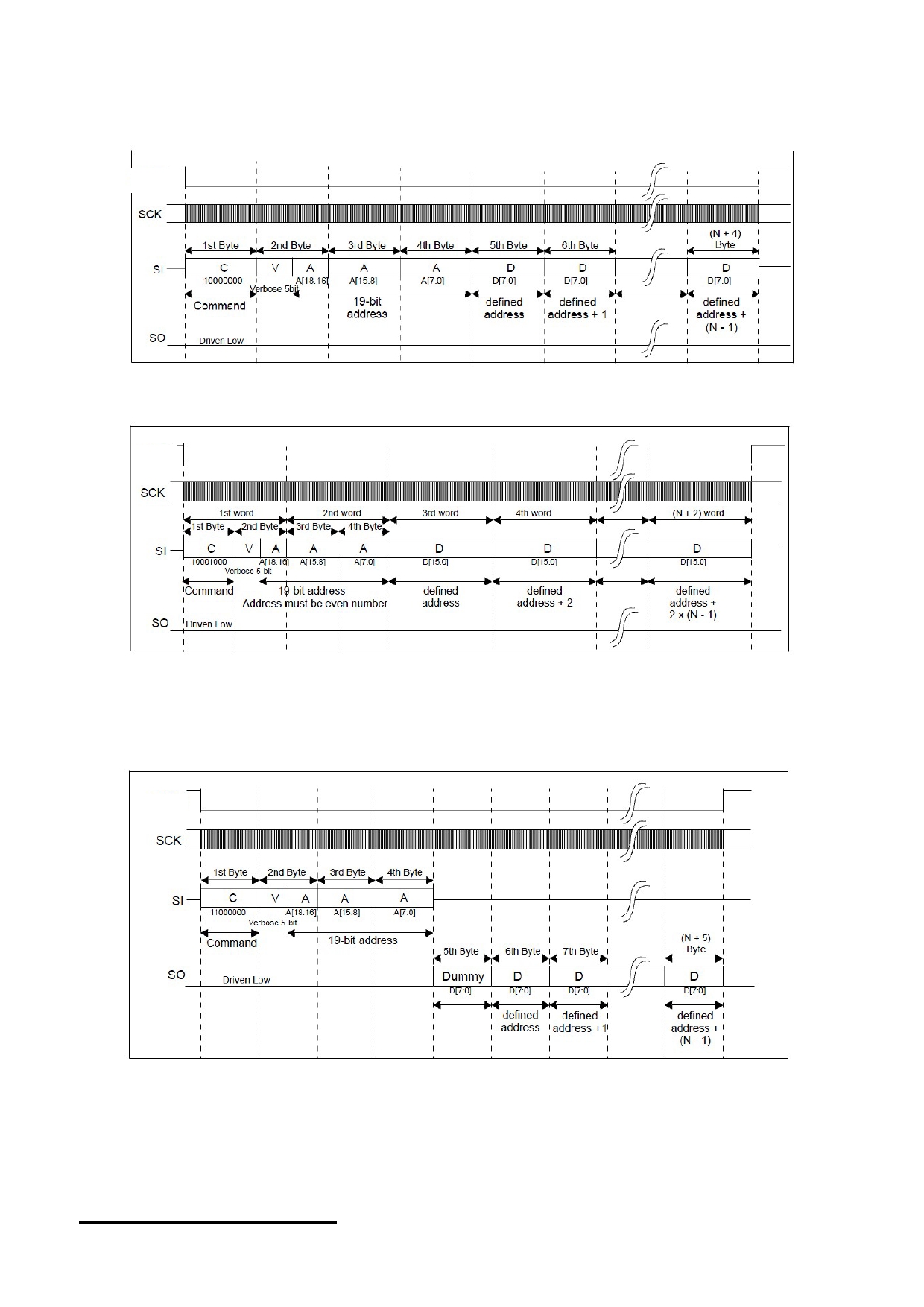
TOPWAY
LCD Module User Manual
LMT035KDH03-NHA-1
Write Procedure:
SPI 8bit Write Sequence:
/CS
Figure 4
SPI 16bit Write Sequence:
/CS
Figure 5
Read Procedure:
SPI 8bit Read Sequence:
/CS
Figure 6
URL: www.topwaydisplay.com
Document Name: LMT035KDH03-NHA-1-Manual-Rev0.1
www.topwaysz.com
Page: 7 of 15
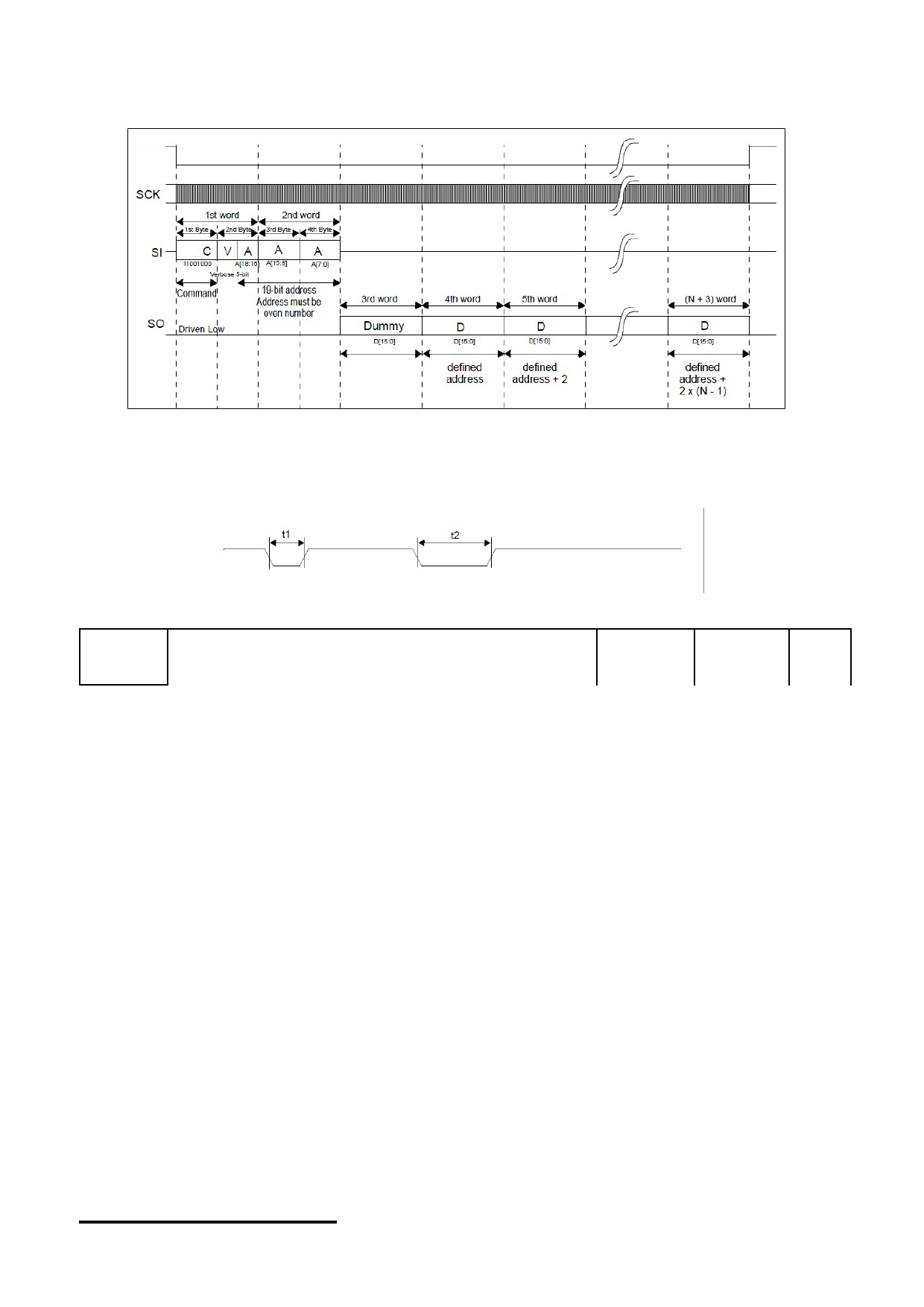
TOPWAY
LCD Module User Manual
LMT035KDH03-NHA-1
SPI 16bit Read Sequence:
/CS
Figure 7
4.2.3 Reset Timing
/RES
Figure 8
Symbol
Parameter
Min
Max
Units
t1
Reset Pulse Width is ignored
-
42
ns
t2
Active Reset Pulse Width (see Note)
150
-
ns
Note: The Reset input should be held low for longer than 150ns to guarantee reset.
For more information and details please refer to LCD controller (S1D13L01) datasheet.
URL: www.topwaydisplay.com
Document Name: LMT035KDH03-NHA-1-Manual-Rev0.1
www.topwaysz.com
Page: 8 of 15
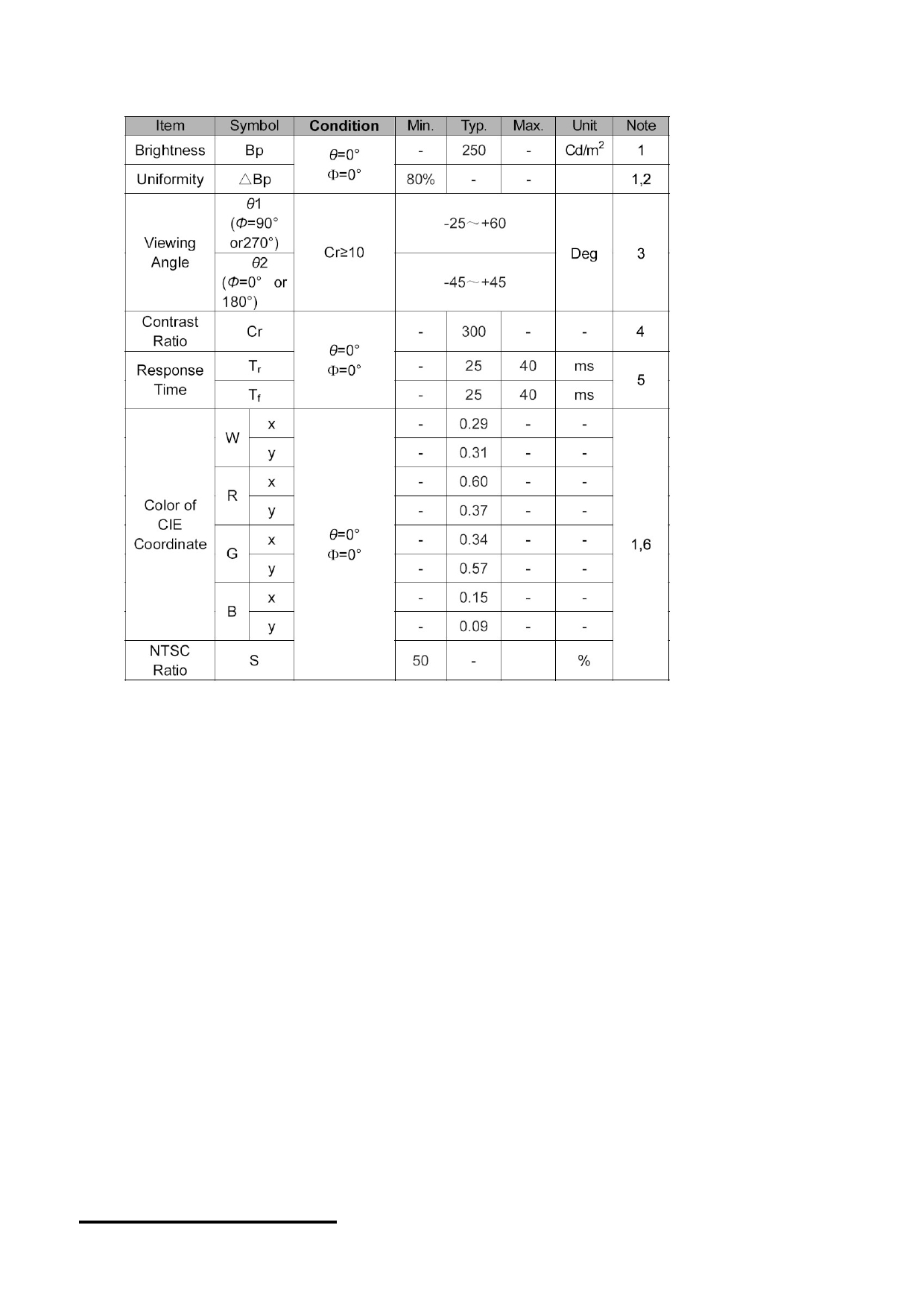
TOPWAY
LCD Module User Manual
LMT035KDH03-NHA-1
5. Optical Characteristics
Note : The parameter may slightly change over temperature, driving voltage and materials.
URL: www.topwaydisplay.com
Document Name: LMT035KDH03-NHA-1-Manual-Rev0.1
www.topwaysz.com
Page: 9 of 15
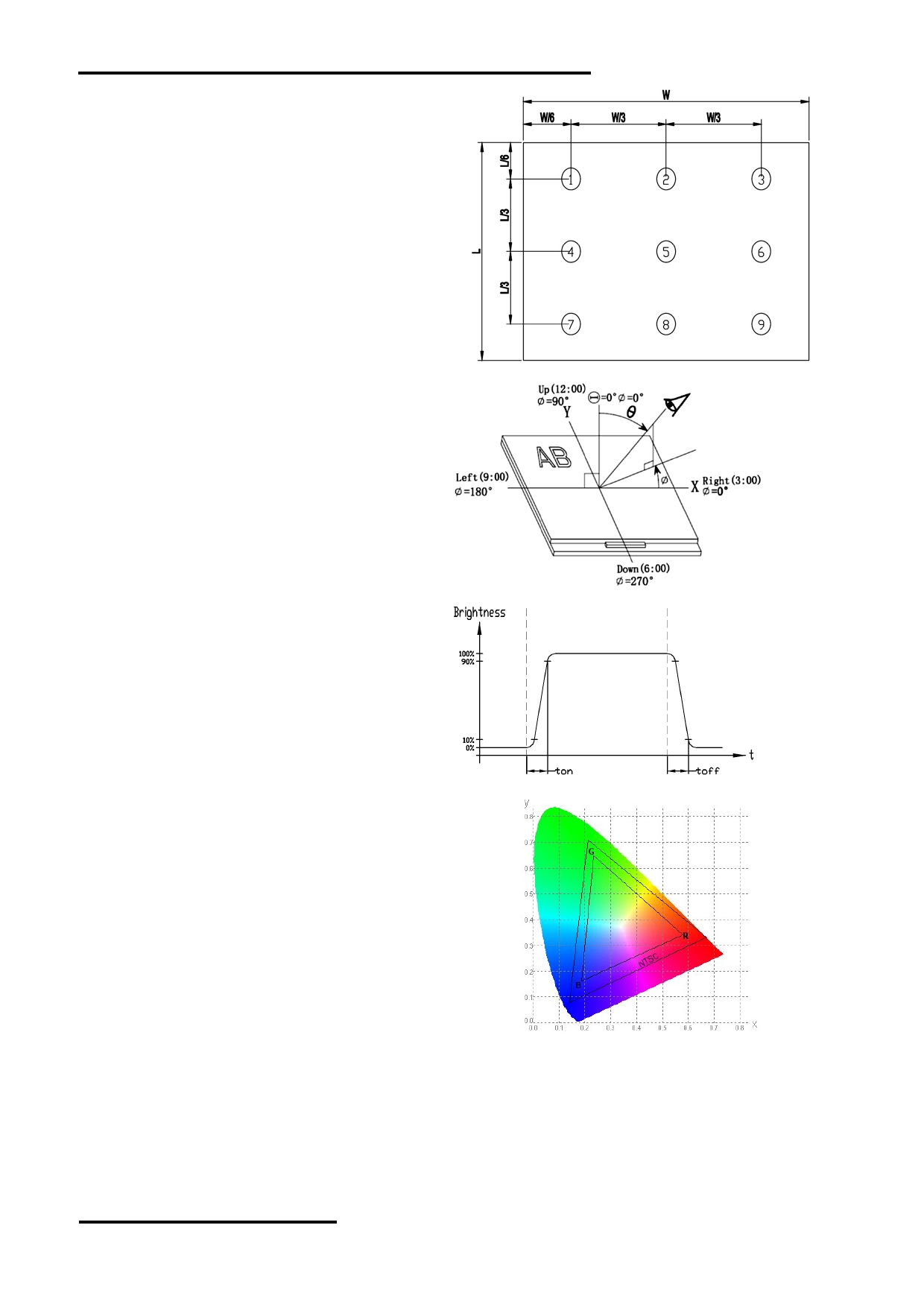
TOPWAY
LCD Module User Manual
LMT035KDH03-NHA-1
Note 1:
The data are measured after LEDs are turned on for 5
minutes. LCM displays full white. The brightness is the
average value of 9 measured spots. Measurement
equipment PR-705 (Φ8mm)
Measuring condition:
- Measuring surroundings: Dark room
- Measuring temperature: Ta=25 ℃ .
- Adjust operating voltage to get optimum
contrast at the center of the display.
Measured value at the center point of LCD panel after more
than 5 minutes while backlight turning on.
Note 2: reference Figure5
The luminance uniformity is calculated by using following
formula.
△ Bp = Bp (Min.) / Bp (Max.)×100 (%)
Bp (Max.) = Maximum brightness in 9 measured
Figure 9
spots
Bp (Min.) = Minimum brightness in 9 measured spots .
Note 3: reference Figure6
The definition of viewing angle:
Refer to the graph below marked by θ and Ф
Note 4:
The definition of contrast ratio (Test LCM using PR-705):
Figure 10
Contrast Luminance When LCD is at “White” state
Ratio(CR)= Luminance When LCD is at “Black” state
(Contrast Ratio is measured in optimum common electrode
voltage)
Note 5: reference Figure7
Definition of Response time. (Test LCD using DMS501):
The output signals of photo detector are measured
when the input signals are changed from
Figure 11
“black” to “white”(falling time)
and from “white” to “black”(rising time), respectively.
The response time is defined as
the time interval between the 10% and 90% of
amplitudes.Refer to figure as below.
Note 6: reference Figure8
Definition of Color of CIE Coordinate and NTSC Ratio.
Color gamut:
Area of RGB triangle
S=
X100%
Area of NTSC triangle
Figure 12
URL: www.topwaydisplay.com
Document Name: LMT035KDH03-NHA-1-Manual-Rev0.1
www.topwaysz.com
Page: 10 of 15
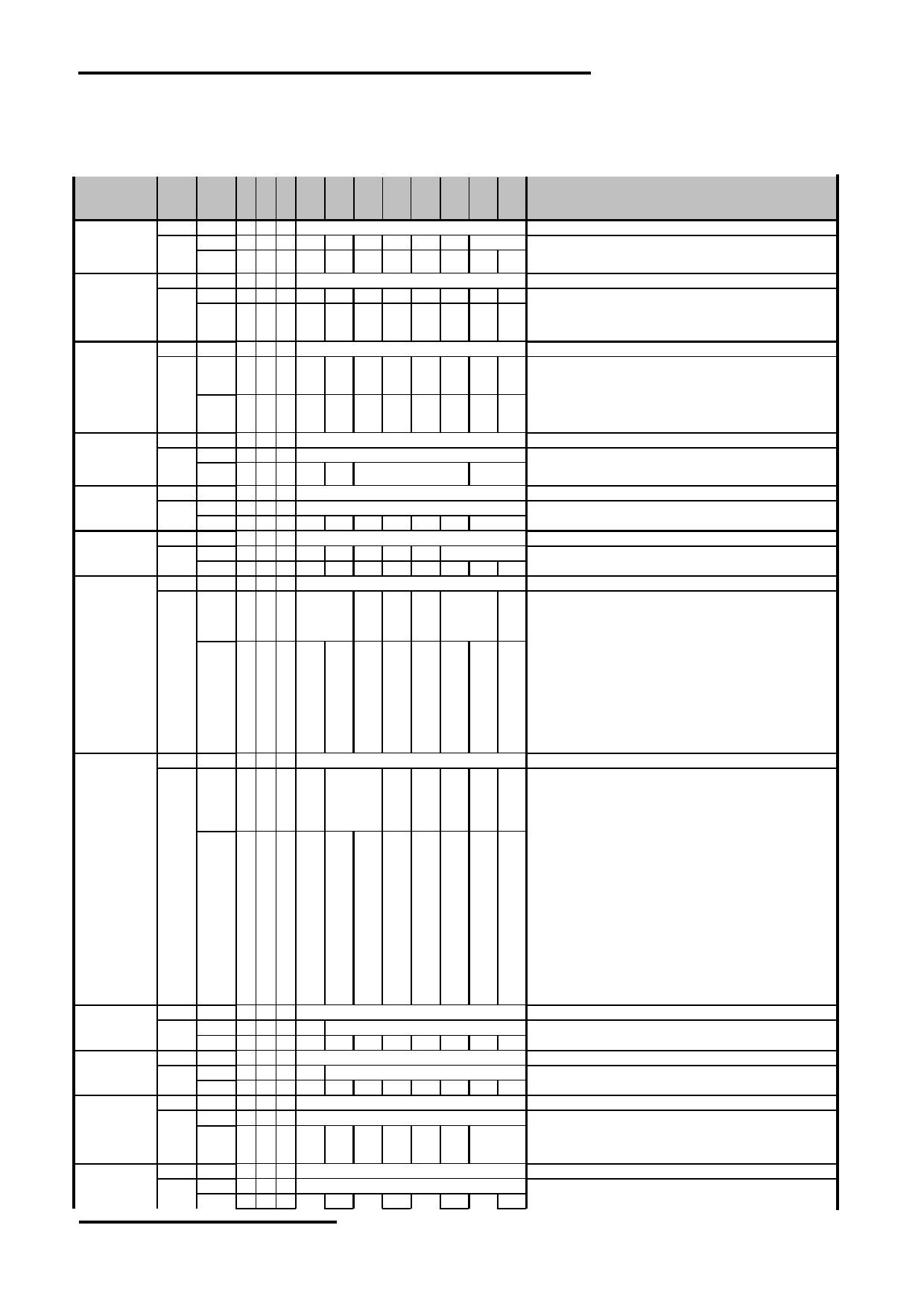
TOPWAY
LCD Module User Manual
LMT035KDH03-NHA-1
6. Function Specifications
6.1 Command Summary
Command
Para-
meter
HEX
Descriptions
Power Save
P1 60804 0 0 0
A[7:0]-> A[15:8] -> A[18:16]
Power Save Configuration Register
D[7:0]
1 0 0 n/a n/a n/a n/a n/a n/a Power Save Bit[1:0] = 00 , PSM0 mode
P2 D[15:8]
Bit[1:0] = 01 , PSM1 mode
1 0 0 n/a n/a n/a n/a n/a n/a n/a n/a
Bit[1:0] = 1x , NMM mode
Software
P1 60806 0 0 0
A[7:0]-> A[15:8] -> A[18:16]
Software Reset Register(Write Only)
Reset
D[7:0]
1 0 0 n/a n/a n/a n/a n/a n/a n/a n/a
D[15:8]
Softw Bit[8] = 0 , no effect in hardware
P2
1 0 0 n/a n/a n/a n/a n/a n/a n/a are Bit[8] = 1 , all registers are reset to default values
Reset
PLL Setting 0 P1 60810 0 0 0
A[7:0]-> A[15:8] -> A[18:16]
PLL Setting Register 0
D[7:0]
PLL PLL Bit[0] = 0 , the PLL is disabled
1 0 0 n/a n/a n/a n/a n/a n/a Bypa Enabl Bit[0] = 1 , the PLL enabled
Bit[1] = 0 , PLL is selected
P2
ss
e
D[15:8]
PLL
Bit[1] = 1 , CLKI is selected
1 0 0 Lock n/a n/a n/a n/a n/a n/a n/a Bit[15] = 0 , the PLL output is not stable
(RO)
Bit[15] = 1 , the PLL output is stable
PLL Setting 1 P1 60812 0 0 0
A[7:0]-> A[15:8] -> A[18:16]
PLL Setting Register 1
D[7:0]
1 0 0
M-Divider
Bit[9:0] 000h,001h … … 019h,020h : 1:1 ,2:1 … … 33:1(M-Divide Ratio).
P2 D[15:8]
021h to 13Fh: Reserved, PFDCLK = CLKI ÷ (M-Divider + 1)
1 0 0 n/a n/a
N-Counter
M-Divider
Bit[13:10] , must be set to 0000
PLL Setting 2 P1 60814 0 0 0
A[7:0]-> A[15:8] -> A[18:16]
PLL Setting Register 2
D[7:0]
1 0 0
L-Counter
Bit[9:0] , must be set between 010h ~ 041h. , and get the M-Divide Ratio
P2
D[15:8]
1 0 0 n/a n/a n/a n/a n/a n/a L-Counter from 17:1 to 66:1. POCLK = (L-Counter + 1) x (N-Counter + 1) x PFDCLK
Internal Clock P1 60816 0 0 0
A[7:0]-> A[15:8] -> A[18:16]
Internal Clock Configuration Register
Configuration
D[7:0]
P2
1 0 0 n/a n/a n/a n/a n/a PCLK Divide Select Bit[3:0] = 0000b,0001b … … 1110b,1111b : 1:1 ,2:1 … … 16:1(MCLK to
D[15:8]
1 0 0 n/a n/a n/a n/a n/a n/a n/a n/a PCLK Frequency Ratio)
Panel Setting P1 60820 0 0 0
A[7:0]-> A[15:8] -> A[18:16]
Panel Setting Miscellaneous Register
Miscellaneous
D[7:0]
Panel
Panel Bit[0] = 0 , TFT panel is disable
PCLK
Data Panel Data Port Bit[0] = 1 , TFT panel is enable
1 0 0 DE Polarity Polari n/a
Enabl
Width
Enabl Bit[2:1] = 01 , TFT 16-bit
ty
e
e
Bit[2:1] = 10 , TFT 18-bit
D[15:8]
Bit[2:1] = 11 , TFT 24-bit
Bit[3] = 0 , panel data is disable
P2
Bit[3] = 1 , panel data is enable
Bit[5] = 0, the LCD data outputs transition on the rising edge of PCLK
1 0 0 n/a n/a n/a n/a n/a n/a n/a n/a Bit[5] = 1 , the LCD data outputs transition on the falling edge of PCLK
Bit[7:6] = 00 , DE Polarity Low active
Bit[7:6] = 01 , DE Polarity High active
Bit[7:6] = 10 , DE Polarity Fixed to Low
Bit[7:6] = 11 , DE Polarity Fixed to High
Display
P1 60822 0 0 0
A[7:0]-> A[15:8] -> A[18:16]
Display Settings Register
Settings
D[7:0]
Displ
Panel Bit[0] = 0 , HS, VS, DE and PCLK are fixed to H or L and the display pipes
TE
Displ
ay
SW Interf are disabled
Statu
1 0 0
TE Function ay
n/a Blank Video ace Bit[0] = 1 , enable the panel output and display pipes
s
Blank
Polari Invert Enabl Bit[1] = 0 , video data is normal
(RO)
ty
es Bit[1] = 1 , video data is inverted
D[15:8]
Bit[2] = 0 , the display blank function operates normally
Bit[2] = 1 , the display blank function switches polarity
Bit[4] = 0 , the LCD data is masked
Bit[4] = 1 , all applicable LCD data outputs are forced to zero or one
P2
Bit[6:5] = 00b , TE output is disabled and the pin output is low
TE
Bit[6:5] = 01b , TE output is high (1) when the display is in the Vertical
Outp
Non-Display Period (VNDP) and low (0) when the display is in Vertical
1 0 0 n/a n/a n/a n/a n/a n/a n/a ut Pin
Display Period (VDISP)
Disab
Bit[6:5] = 10b , Line Count
le
Bit[6:5] = 11b , Reserved
Bit[7] = 0 , the selected condition in not occurring
Bit[7] = 1 , the selected condition in not occurring
Bit[8] = 0 , TE is output
Bit[8] = 1 , TE is not output
HDISP
P1 60824 0 0 0
A[7:0]-> A[15:8] -> A[18:16]
Horizontal Display Width Register (HDISP)
D[7:0]
Horizontal Display Width
P2
1 0 0 n/a
Bit[6:0] = horizontal display width in pixels ÷ 8
D[15:8]
1 0 0 n/a n/a n/a n/a n/a n/a n/a n/a
HNDP
P1 60826 0 0 0
A[7:0]-> A[15:8] -> A[18:16]
Horizontal Non-Display Period Register (HNDP)
D[7:0]
1 0 0 n/a
Horizontal Non-Display Period
P2
Bit[6:0] = horizontal non-display period in PCLK’s
D[15:8]
1 0 0 n/a n/a n/a n/a n/a n/a n/a n/a
VDISP
P1 60828 0 0 0
A[7:0]-> A[15:8] -> A[18:16]
Vertical Display Height Register (VDISP)
D[7:0]
1 0 0
Vertical Display Height
P2
D[15:8]
Vertical
Bit[9:0] = vertical display height in lines
1 0 0 n/a n/a n/a n/a n/a n/a
Display
Height
VNDP
P1 6082A 0 0 0
A[7:0]-> A[15:8] -> A[18:16]
Vertical Non-Display Period Register (VNDP)
D[7:0]
1 0 0
Vertical Non-Display Period
P2
Bit[7:0] = vertical non-display period in lines
D[15:8]
1 0 0 n/a n/a n/a n/a n/a n/a n/a n/a
URL: www.topwaydisplay.com
Document Name: LMT035KDH03-NHA-1-Manual-Rev0.1
www.topwaysz.com
Page: 11 of 15
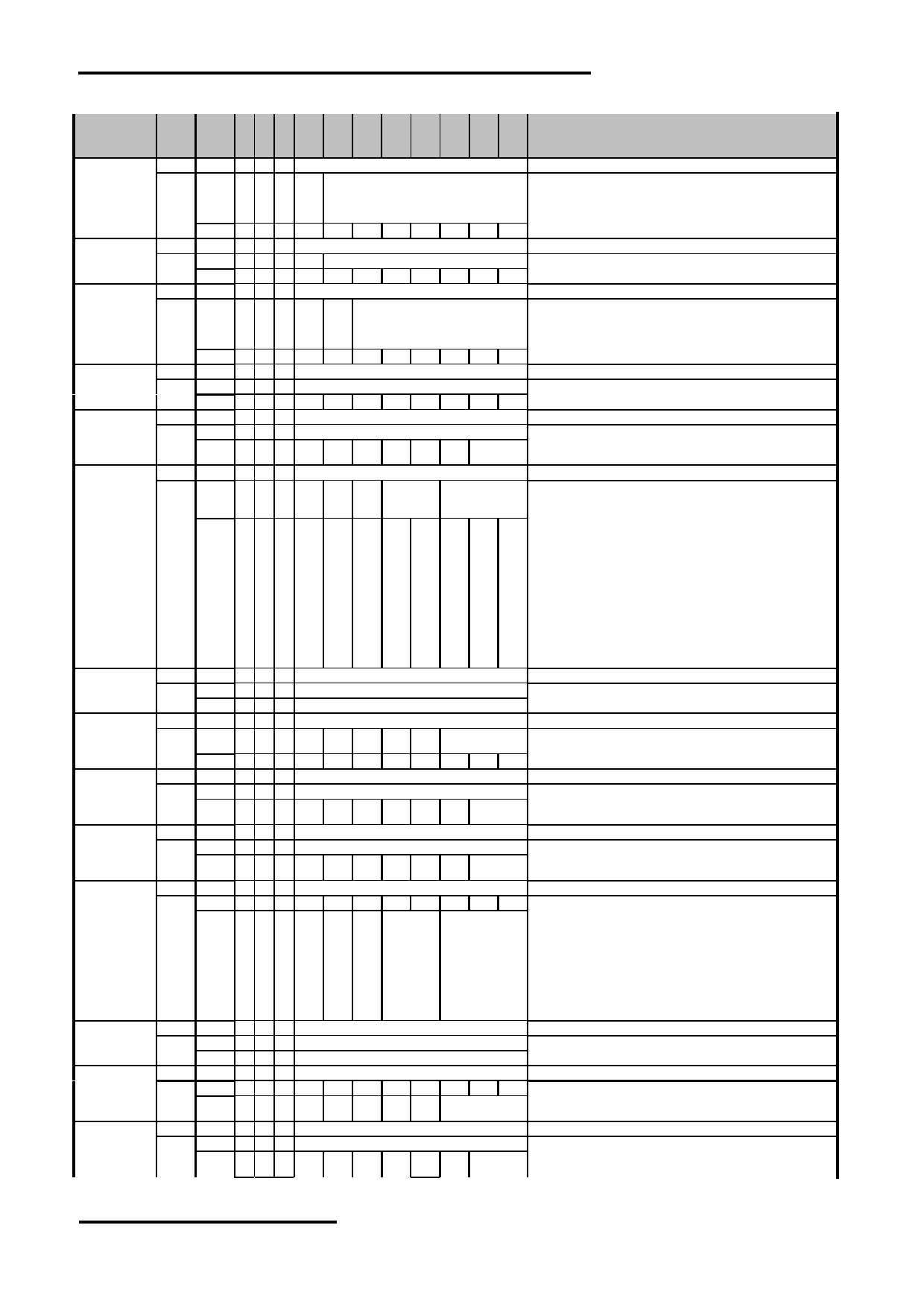
TOPWAY
LCD Module User Manual
LMT035KDH03-NHA-1
Command
Para-
meter
HEX
Descriptions
HSW
P1 6082C 0 0 0
A[7:0]-> A[15:8] -> A[18:16]
HS Pulse Width Register (HSW)
D[7:0]
HS
Pulse
1 0 0
HS Pulse Width
Bit[6:0] = HS pulse width in PCLK’s
P2
Polari
Bit[7] = 0 , the horizontal sync signal is active low
ty
Bit[7] = 1 , the horizontal sync signal is active high
D[15:8]
1 0 0 n/a n/a n/a n/a n/a n/a n/a n/a
HPS
P1 6082E 0 0 0
A[7:0]-> A[15:8] -> A[18:16]
HS Pulse Start Position Register (HPS)
D[7:0]
HS Pulse Start Position
P2
1 0 0 n/a
Bit[6:0] = HS pulse start position in PCLK’s
D[15:8]
1 0 0 n/a n/a n/a n/a n/a n/a n/a n/a
VSW
P1 60830 0 0 0
A[7:0]-> A[15:8] -> A[18:16]
VS Pulse Width Register (VSW)
D[7:0]
VS
Pulse
1 0 0
n/a
VS Pulse Width
Bit[5:0] = VS pulse width in lines
P2
Polari
Bit[7] = 0 , the vertical sync signal is active low
ty
Bit[7] = 1 , the vertical sync signal is active high
D[15:8]
1 0 0 n/a n/a n/a n/a n/a n/a n/a n/a
VPS
P1 60832 0 0 0
A[7:0]-> A[15:8] -> A[18:16]
VS Pulse Start Position Register (VPS)
D[7:0]
VS Pulse Start Position
P2
1 0 0
Bit[7:0] = VS pulse start position in lines
D[15:8]
1 0 0 n/a n/a n/a n/a n/a n/a n/a n/a
TE Line Count P1 60834 0 0 0
A[7:0]-> A[15:8] -> A[18:16]
TE Line Count Register
D[7:0]
1 0 0
TE Line Count
These bits specify the line count value that is compared with the internal
P2 D[15:8]
TE Line
1 0 0 n/a n/a n/a n/a n/a n/a
vertical line counter
Count
Main Layer
P1 60840 0 0 0
A[7:0]-> A[15:8] -> A[18:16]
Main Layer Setting Register
Setting
D[7:0]
Main Layer
Main Layer Color
1 0 0 n/a n/a n/a
Rotation
Depth
Bit[2:0] = 000b, RGB 8:8:8 (default)
Select
Bit[2:0] = 001b, RGB 5:6:5
D[15:8]
Multi-
Bit[2:0] = 010b/011b/111b, Reserved
Byte
Bit[2:0] = 100b, 24 bpp + LUT1
Layer
Bit[2:0] = 101b, 16 bpp + LUT1
Regis
Bit[2:0] = 110b, 8 bpp + LUT1
P2
ters
Bit[4:3] = 00b, 0° (Normal)
Sync
1 0 0 n/a n/a n/a n/a n/a n/a n/a
Bit[4:3] = 01b, 90°
hrono
Bit[4:3] = 10b, 180°
us
Bit[4:3] = 11b, 270°
Latch
Bit[8] = 0, Synchronous latching of multi-byte layer registers is enabled
ing
Bit[8] = 1, Synchronous latching of multi-byte layer registers is disabled
Disab
le
Main Layer
P1 60842 0 0 0
A[7:0]-> A[15:8] -> A[18:16]
Main Layer Start Address Register 0
Start Address
D[7:0]
1 0 0
Main Layer Start Address
Bit[15:0] is Bit[15:0] of Main Layer Start Address ,but Bit[1:0] must be set
0
P2
D[15:8]
1 0 0
Main Layer Start Address
to 00b
Main Layer
P1 60844 0 0 0
A[7:0]-> A[15:8] -> A[18:16]
Main Layer Start Address Register 1
Start Address
D[7:0]
Main Layer Start
1 0 0 n/a
n/a
n/a
n/a
1
P2
Address
Bit[2:0] is Bit[18:16] of Main Layer Start Address
D[15:8]
1 0 0 n/a n/a n/a n/a n/a n/a n/a n/a
Main Layer
P1 60846 0 0 0
A[7:0]-> A[15:8] -> A[18:16]
Main Layer Width Register
Width
D[7:0]
1 0 0
Main Layer Width
P2 D[15:8]
Main Layer Read Only
1 0 0 n/a n/a n/a n/a n/a n/a
Width
Main Layer
P1 60848 0 0 0
A[7:0]-> A[15:8] -> A[18:16]
Main Layer Height Register
Height
D[7:0]
1 0 0
Main Layer Height
P2 D[15:8]
Main Layer Read Only
1 0 0 n/a n/a n/a n/a n/a n/a
Height
PIP Layer
P1 60850 0 0 0
A[7:0]-> A[15:8] -> A[18:16]
PIP Layer Setting Register
Setting
D[7:0]
1 0 0 n/a n/a n/a n/a n/a n/a n/a n/a Bit[2:0] = 000b, RGB 8:8:8 (default)
D[15:8]
Bit[2:0] = 001b, RGB 5:6:5
Bit[2:0] = 010b/011b/111b, Reserved
Bit[2:0] = 100b, 24 bpp + LUT1
PIP Layer
Bit[2:0] = 101b, 16 bpp + LUT1
P2
PIP Layer Color
1 0 0 n/a n/a n/a
Rotation
Bit[2:0] = 110b, 8 bpp + LUT1
Depth
Select
Bit[4:3] = 00b, 0° (Normal)
Bit[4:3] = 01b, 90°
Bit[4:3] = 10b, 180°
Bit[4:3] = 11b, 270°
PIP Layer
P1 60852 0 0 0
A[7:0]-> A[15:8] -> A[18:16]
PIP Layer Start Address Register 0
Start Address
D[7:0]
1 0 0
PIP Layer Start Address
Bit[15:0] is Bit[15:0] of Main Layer Start Address ,but Bit[1:0] must be set
0
P2
D[15:8]
1 0 0
PIP Layer Start Address
to 00b
PIP Layer
P1 60854 0 0 0
A[7:0]-> A[15:8] -> A[18:16]
PIP Layer Start Address Register 1
Start Address
D[7:0]
1 0 0 n/a n/a n/a n/a n/a n/a n/a n/a
1
P2 D[15:8]
PIP Layer Start
Bit[2:0] is Bit[18:16] of Main Layer Start Address
1 0 0 n/a n/a n/a n/a n/a
Address
PIP Layer
P1 60856 0 0 0
A[7:0]-> A[15:8] -> A[18:16]
PIP Layer Width Register
Width
D[7:0]
1 0 0
PIP Layer Width
Bit[9:] = PIP Layer Horizontal Display Period in number of pixels PIP
P2 D[15:8]
PIP Layer
1 0 0 n/a n/a n/a n/a n/a n/a
Layer Horizontal Display Period in number of pixels
Width
URL: www.topwaydisplay.com
Document Name: LMT035KDH03-NHA-1-Manual-Rev0.1
www.topwaysz.com
Page: 12 of 15

TOPWAY
LCD Module User Manual
LMT035KDH03-NHA-1
Command
Para-
meter
HEX
Descriptions
PIP Layer
P1 60858 0 0 0
A[7:0]-> A[15:8] -> A[18:16]
PIP Layer Height Register
Height
D[7:0]
1 0 0
PIP Layer Height
P2 D[15:8]
PIP Layer Bit[9:] = PIP Layer Vertical Display Period in number of lines
1 0 0 n/a n/a n/a n/a n/a n/a
Height
PIP Layer X
P1 6085A 0 0 0
A[7:0]-> A[15:8] -> A[18:16]
PIP Layer X Start Position Register
Start Position
D[7:0]
1 0 0
PIP Layer X Start Position
P2
D[15:8]
PIP Layer X
These bits specify X start position of the PIP Layer on the panel, in lines
1 0 0 n/a n/a n/a n/a n/a n/a
Start
Position
PIP Layer Y
P1 6085C 0 0 0
A[7:0]-> A[15:8] -> A[18:16]
PIP Layer Y Start Position Register
Start Position
D[7:0]
1 0 0
PIP Layer Y Start Position
P2
D[15:8]
PIP Layer Y
These bits specify Y start position of the PIP Layer on the panel, in lines
1 0 0 n/a n/a n/a n/a n/a n/a
Start
Position
PIP Enable
P1 60860 0 0 0
A[7:0]-> A[15:8] -> A[18:16]
PIP Enable Register
D[7:0]
Blink/
Bit[2:0] = 000b, Blank
Fade
Bit[2:0] = 001b, Normal
1 0 0 n/a n/a n/a n/a
Blink/Fade Effect
Status
Bit[2:0] = 010b, Blink 1
(RO)
Bit[2:0] = 011b, Blink 2
D[15:8]
Bit[2:0] = 100b, Fade Out
P2
Bit[2:0] = 101b, Fade In
Bit[2:0] = 110b, Fade In/Out Continuous
1 0 0
Blink/Fade Period
n/a Bit[2:0] = 111b, Reserved
Bit[3] = 0b, the PIP layer is not blinking or fading
Bit[3] = 1b, the PIP layer is in the process of blinking or fading
Bit[15:9] = blink/fade period in frames – 1
Alpha
P1 60862 0 0 0
A[7:0]-> A[15:8] -> A[18:16]
Alpha Blending Register
Blending
D[7:0]
1 0 0 n/a
Alpha Blending Ratio
Bit[6:0] = 0000000b,0000001b… …0111111b,1000000b :
D[15:8]
64:0 (no PIP),63:1 … … 1:63,0:64(full PIP) ;
1000001b ~ 1111111b : Reserved
P2
Alpha
Bit[9:8] = 00b, 1
1 0 0 n/a n/a n/a n/a n/a n/a
Blending
Bit[9:8] = 01b, 2
Step
Bit[9:8] = 10b, 4
Bit[9:8] = 11b, 8
Transparency P1 60864 0 0 0
A[7:0]-> A[15:8] -> A[18:16]
Transparency Register
D[7:0]
Transp
1 0 0 n/a n/a n/a n/a n/a n/a n/a arency Bit[0] = 0b, transparency is disabled
P2
Enable Bit[0] = 1b, transparency is enabled
D[15:8]
1 0 0 n/a n/a n/a n/a n/a n/a n/a n/a
Transparency P1 60866 0 0 0
A[7:0]-> A[15:8] -> A[18:16]
Transparency Key Color Register 0
Key Color 0
D[7:0]
Key Color Blue
Bit[15:8] is Key Color Green bits [7:0]
P2
1 0 0
D[15:8]
1 0 0
Key Color Green
Bit[7:0] is Key Color Blue bits [7:0]
Transparency P1 60868 0 0 0
A[7:0]-> A[15:8] -> A[18:16]
Transparency Key Color Register 1
Key Color 1
D[7:0]
Key Color Red
P2
1 0 0
Bit[7:0] is Key Color Red bits [7:0]
D[15:8]
1 0 0 n/a n/a n/a n/a n/a n/a n/a n/a
GPIO
P1 608D0 0 0 0
A[7:0]-> A[15:8] -> A[18:16]
GPIO Configuration Register
Configuration
D[7:0]
Bit[15:0] = 0b (default), the corresponding GPIO pin is configured as an
1 0 0 GPIO7 GPIO6 GPIO5 GPIO4 GPIO3 GPIO2 GPIO1 GPIO0
Config
Config
Config
Config
Config
Config
Config
Config input pin
P2
D[15:8]
Bit[15:0] = 1b , the corresponding GPIO pin is configured as an output pin
1 0 0 GPIO15 GPIO14 GPIO13 GPIO12 GPIO11 GPIO10 GPIO9 GPIO8
Config
Config
Config
Config
Config
Config
Config
Config
GPIO Status P1 608D2 0 0 0
A[7:0]-> A[15:8] -> A[18:16]
GPIO Status and Control Register
and Control
D[7:0]
1 0 0 GPIO7 GPIO6 GPIO5 GPIO4 GPIO3 GPIO2 GPIO1 GPIO0 When GPIOx is configured as an output:
Status
Status
Status
Status
Status Status
Status
Status
P2
Bit[15:0] = 0b, GPIOx low
D[15:8]
1 0 0 GPIO15 GPIO14 GPIO13 GPIO12 GPIO11 GPIO10 GPIO9 GPIO8 Bit[15:0] = 1b, GPIOx high
Status
Status
Status
Status
Status
Status
Status
Status
GPIO Pull-
P1 608D4 0 0 0
A[7:0]-> A[15:8] -> A[18:16]
GPIO Pull-Down Control Register
Down Control
D[7:0]
GPIO7
GPIO6
GPIO5
GPIO4
GPIO3
GPIO 2
GPIO1
GPIO0
1 0 0 Pull- Pull- Pull- Pull- Pull- Pull- Pull- Pull-
down
down
down
down
down
down
down
down
Bit[15:0] = 0b, the pull-down resistor for the associated GPIO pin is
Control
P2
Control
Control
Control
Control
Control
Control
Control
inactive.
D[15:8]
GPIO15 GPIO14 GPIO13 GPIO12 GPIO11 GPIO10 GPIO9
GPIO8
Bit[15:0] = 1b, the pull-down resistor for the associated GPIO pin is active.
1 0 0 Pull- Pull- Pull- Pull- Pull- Pull- Pull- Pull-
down
down
down
down
down
down
down
down
Control
Control
Control
Control
Control
Control
Control
Control
Note: Access of PLL Setting 0, PLL Setting 1, PLL Setting 2 and Internal Clock Configuration is only possible
in Power Save Mode PSM0.
For more information and details please refer to S1D13L01 datasheet.
URL: www.topwaydisplay.com
Document Name: LMT035KDH03-NHA-1-Manual-Rev0.1
www.topwaysz.com
Page: 13 of 15

TOPWAY
LCD Module User Manual
LMT035KDH03-NHA-1
7. LCD Module Design and Handling
7. 液晶显示模块设计和使用须知
Precautions
- Please ensure V0, VCOM is adjustable, to enable LCD module get - 请注意 V0, VCOM 的设定, 以确保液晶显示模块在不同
the best contrast ratio under different temperatures, view angles
的使用温度下以及在不同的视角和位置观察模块显
and positions.
示,均能达到最佳对比度,请务必将应用电路上设置
为对比度可调。
- Normally display quality should be judged under the best contrast - 请注意液晶显示模块的显示品质判定是指在正常对比
ratio within viewable area. Unexpected display pattern may com out
度下以及视窗(V.A)范围内进行的,非正常对比度下液
under abnormal contrast ratio.
晶可能会出现非预期的显示不良,应注意区分。
- Never operate the LCD module exceed the absolute maximum - 请勿在最大额定值以外使用液晶显示模块。
ratings.
- Never apply signal to the LCD module without power supply.
- 请勿在没有接通电源的条件下,给液晶显示模块输送
信号。
- Keep signal line as short as possible to reduce external noise - 请尽可能缩短信号线的连接,以避免对液晶显示模块
interference.
的信号干扰。
- IC chip (e.g. TAB or COG) is sensitive to light. Strong light might - 集成电路因 IC 芯片(如 TAB 或 COG)对紫外线极为敏
cause malfunction. Light sealing structure casing is recommended.
感,强光环境下可能会引起液晶显示模块功能失效,
故应采用不透光的外壳。
- Make sure there is enough space (with cushion) between case and - 请在液晶显示模块与外壳之间保留足够的空间(可使用
LCD panel, to prevent external force passed on to the panel;
衬垫),以缓冲外力对液晶显示模块的损坏或因受力不
otherwise that may cause damage to the LCD and degrade its
均而产生的显示不匀等异常现象。
display result.
- Avoid showing a display pattern on screen for a long time - 避免液晶显示屏在某一画面下长时间点亮,否则有出
(continuous ON segment).
现残影的风险;请通过软件每隔一段时间改变一次画
面。
- LCD module reliability may be reduced by temperature shock.
- 液晶显示模块的可靠性可能因温度冲击而降低。
- When storing and operating LCD module, avoids exposure to direct - 请勿在阳光直射、高湿、高温或低温下储存和使用液
sunlight, high humidity, high or low temperature. They may damage
晶显示模块,这将造成液晶显示模块的损坏或失效。
or degrade the LCD module.
- Never leave LCD module in extreme condition (max./min - 请勿在极限环境(最大/最小存储/工作温度)下使用或
storage/operate temperature) for more than 48hr.
放置液晶显示模块超过 48 小时以上。
- Recommend LCD module storage conditions is 0 C~40 C - 液晶显示模块建议存储条件为: 0 C~40 C <80%RH 。
<80%RH.
- 请勿让液晶显示模块存储于带有 酸性, 碱性, 有害气
- LCD module should be stored in the room without acid, alkali and
体环境之中。
harmful gas.
- 在运输过程中, 请勿让液晶显示模块跌落与猛烈震动,
- Avoid dropping & violent shocking during transportation, and no
同时避免 异常挤压, 高湿度, 与阳光照射.
excessive pressure press, moisture and sunlight.
- 液晶显示模块极易受静电损坏,请务必保证液晶显示
- LCD module can be easily damaged by static electricity. Please
模块在防静电的工作环境中使用或保存。(如: 烙铁正
maintain an optimum anti-static working environment to protect the
确接地,等)
LCD module. (eg. ground the soldering irons properly)
- 拿取液晶显示模块时需注意操作人员的接地情况。
- Be sure to ground the body when handling LCD module.
- 请手持液晶显示模块的边沿取放模块,防止热压纸或
- Only hold LCD module by its sides. Never hold LCD module by
TAB 部位受力。
applying force on the heat seal or TAB.
- 焊接液晶模块时,请注意控制烙铁的温度、焊接时
- When soldering, control the temperature and duration avoid
间,以免烫坏导光板或偏光片,导致显示不匀等不良
damaging the backlight guide or diffuser which might degrade the
现象发生。
display result such as uneven display.
- 请勿使用洗板水等腐蚀性液体接触液晶模块,以免腐
- Never let LCD module contact with corrosive liquids, which might
蚀导光板或模块电路。
cause damage to the backlight guide or the electric circuit of LCD
module.
- 仅可使用柔软的干布, 异丙醇或乙醇清洁液晶屏表
- Only clean LCD with a soft dry cloth, Isopropyl Alcohol or Ethyl
面,其他任何溶剂(如:水)都有可能损坏液晶模块。
Alcohol. Other solvents (e.g. water) may damage the LCD.
- 请勿挤压液晶显示模块上的元器件,以避免产生潜在
- Never add force to components of LCD module. It may cause
的损坏或失效而影响产品可靠性。
invisible damage or degrade the module's reliability.
- 装配液晶显示模块时,请务必注意避免液晶显示模块
- When mounting LCD module, please make sure it is free from
的扭曲或变形。
twisting, warping and bending.
- 请勿挤压液晶显示屏表面,这将导致显示颜色的异
- Do not add excessive force on surface of LCD, which may cause
常。
the display color change abnormally.
- 液晶屏由玻璃制作而成,任何机械碰撞(如从高处跌
- LCD panel is made with glass. Any mechanical shock (e.g.
落)均有可能损坏液晶显示模块。
dropping from high place) will damage the LCD module.
URL: www.topwaydisplay.com
Document Name: LMT035KDH03-NHA-1-Manual-Rev0.1
www.topwaysz.com
Page: 14 of 15
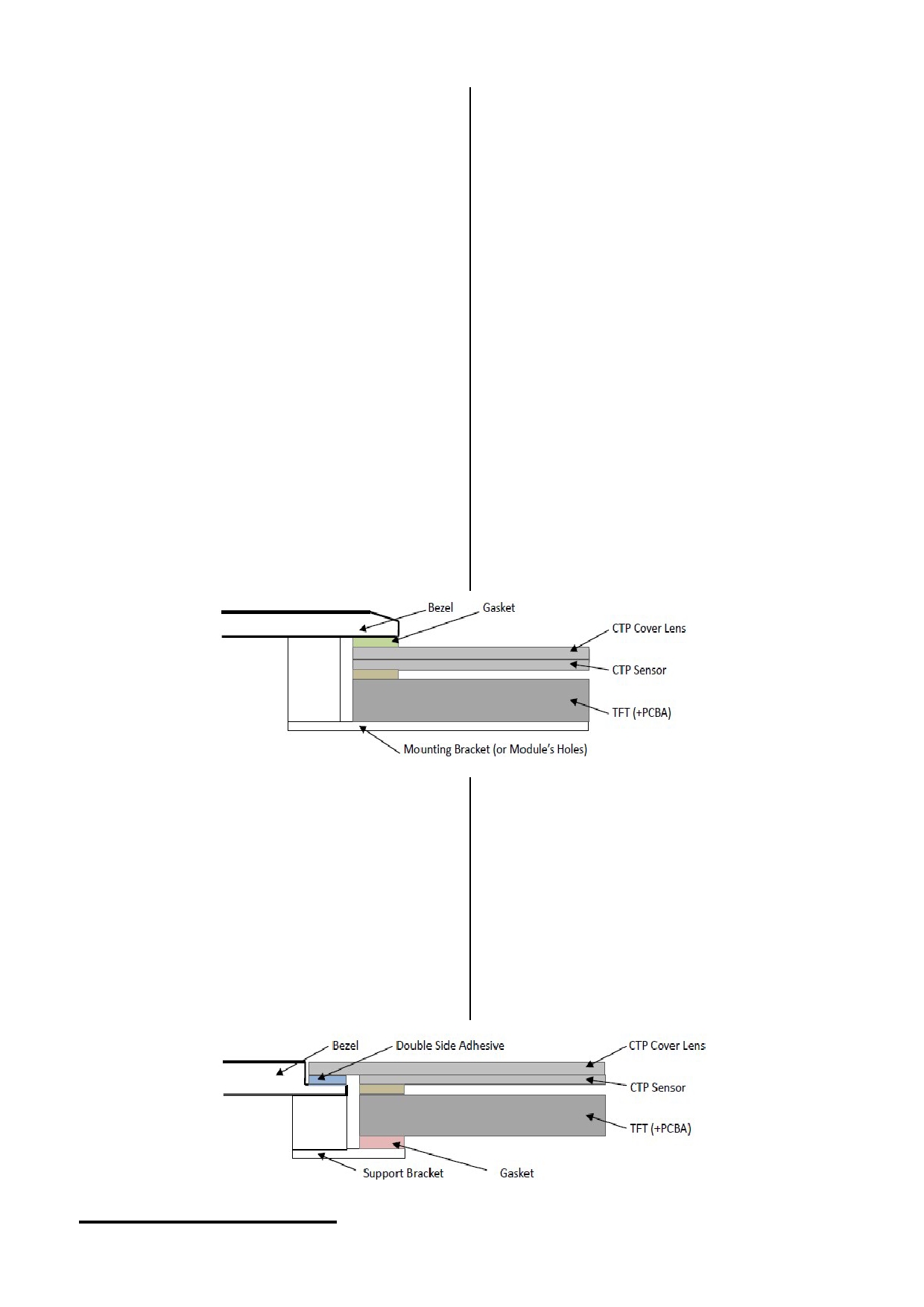
TOPWAY
LCD Module User Manual
LMT035KDH03-NHA-1
- Protective film is attached on LCD screen. Be careful when peeling - 液晶屏表面带有保护膜, 揭除保护膜时需要注意可能
off this protective film, since static electricity may be generated.
产生的静电。
- Polarizer on LCD gets scratched easily. If possible, do not remove - 因液晶显示屏表面的偏光片极易划伤,安装完成之前
LCD protective film until the last step of installation.
请尽量不要揭下保护膜。
- When peeling off protective film from LCD, static charge may cause - 请缓慢揭除保护膜,在此过程中液晶显示屏上可能会
abnormal display pattern. The symptom is normal, and it will turn
产生静电线,此为正常情况,可在短时间内消失。
back to normal in a short while.
- LCD panel has sharp edges, please handle with care.
- 请注意避免被液晶显示屏的边缘割伤。
- Never attempt to disassemble or rework LCD module.
- 请不要试图拆卸或改造液晶显示模块。
- If display panel is damaged and liquid crystal substance leaks out, - 当液晶显示屏出现破裂, 内部液晶液体可能流出; 相
be sure not to get any in your mouth, if the substance comes into
关液体不可吞吃, 绝对不可接触嘴巴, 如接触到皮肤
contact with your skin or clothes promptly wash it off using soap
或衣服, 请使用肥皂与清水彻底清洗.
and water.
8. CTP Mounting Instructions
8. 电容触摸屏安装指导
8.1 Bezel Mounting (Figure 1)
8.1 面框安装(附图 1)
- The bezel window should be bigger than the CTP active area. It
- 客户面框窗口应大于 CTP 动作区域,各边离动作区应
should be ≥ 0.5mm each side.
≥0.5mm.
- Gasket should be installed between the bezel and the CTP surface.
- 面框与 CTP 面板间应垫有胶垫,其最终间隙约为 0.5~
The final gap should be about 0.5~1.0mm.
1.0mm.
- It is recommended to provide an additional support bracket for
- 建议必要时在背面提供附加支架(例如无安装结构的薄
backside support when necessary (e.g. slim type TFT module
型 TFT 模块),应仅利用适当支撑以保持模块位置.
without mounding structure). They should only provide appropriate
support and keep the module in place.
- The mounting structure should be strong enough to prevent
- 安装结构应具有足够的强度,以防止外部不均匀力或
external uneven force or twist act onto the module.
扭曲力作用到模块上.
Figure 1
8.2 Surface Mounting (Figure 2)
8.2 嵌入安装(附图 2)
- As the CTP assembling on the countersink area with double side - 客户面框应具有使用双面胶粘贴 CTP 的结构沉台面,
adhesive.
其粘贴面要求平整且洁净无污以保证粘贴牢靠.
The countersink area should be flat and clean to ensure the double
side adhesive installation result.
- The Bezel is recommend to keep a gap ( ≥ 0.3mm each side) - 考虑到制作误差,建议面框与 CTP 盖板之间四周留有
around the cover lens for tolerance.
≥0.3mm 间隙.
- It is recommended to provide an additional support bracket with - 建议必要时在背面提供垫有胶垫附加支架(例如无安装
gasket for backside support when necessary (e.g. TFT module
结构的 TFT 模块),应仅利用适当支撑以保持模块位
without mounding structure). They should only provide appropriate
置.
support and keep the module in place.
- The mounting structure should be strong enough to prevent - 安装结构应具有足够的强度,以防止外部不均匀力或
external uneven force or twist act onto the module
扭曲力作用到模块上。
Figure 2
URL: www.topwaydisplay.com
Document Name: LMT035KDH03-NHA-1-Manual-Rev0.1
www.topwaysz.com
Page: 15 of 15
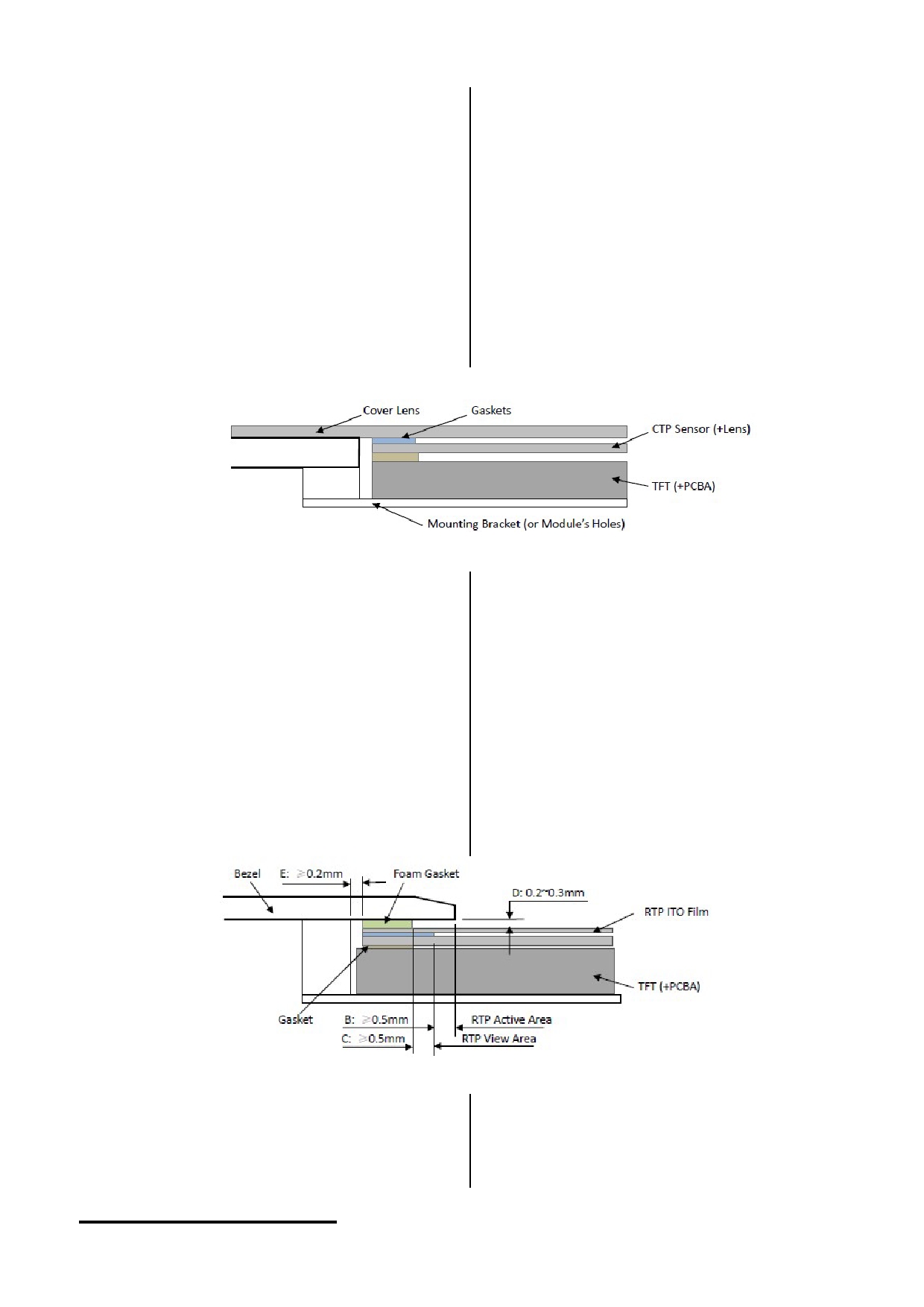
TOPWAY
LCD Module User Manual
LMT035KDH03-NHA-1
8.3 Additional Cover Lens Mounting (Figure 3)
8.3 覆加盖板(附图 3)
- For the case of additional cover Lens mounting, it is necessary to - 需要覆加玻璃盖板的安装,为确保其功能,有必要查
recheck with the CTP specification about the material and thickness
看产品规格书中有关盖板材料和厚度的说明.
to ensure the functionality.
- It should keep a 0.2~0.3mm gap between the cover lens and the - 玻璃盖板与 CTP 表面之间应留有 0.2~0.3mm 间隙.
CTP surface..
- The cover lens window should be bigger than the active area of the - 玻璃盖板视窗应大于 CTP 动作区域,各边离动作区应
CTP.It should be ≥ 0.5mm each side.
≥0.5mm。
- It is recommended to provide an additional support bracket for - 建议必要时在背面提供附加支架(例如无安装结构的薄
backside support when necessary (e.g. slim type TFT module
型 TFT 模块),应仅利用适当支撑以保持模块位置.
without mounding structure). They should only provide appropriate
support and keep the module in place.
- The mounting structure should be strong enough to prevent - 安装结构应具有足够的强度,以防止外部不均匀力或
external uneven force or twist act onto the module.
扭曲力作用到模块上.
Figure 3
9. RTP Mounting Instructions
9. 电阻触摸屏安装指导
- It should bezel touching the RTP Active Area (A.A.) to prevent
- 为避免面框直接压在动作区(A.A.)上造成误动作,面框
abnormal touch.It should left gab D=0.2~0.3mm in between.
与电阻触摸屏(RTP)之间应留有一定的空隙
(Figure 4)
D=0.2~0.3mm 之间.(附图 4)
- Outer bezel design should take care about the area outside the
- 设计面框时,要注意用面框保护触摸屏四周的非保证操
A.A. Those areas contain circuit wires which is having different
作区域,因为布线区域在此处形成一台阶,在此区域
thickness. Touching those areas could de-form the ITO film. As a
附近操作时 ITO Film 变形较大,容易导致 ITO 损坏而
result bezel the ITO film be damaged and shorten its lifetime.
降低寿命。为保护 RTP 和避免误操作,在 RTP 与面框
It is suggested to protect those areas with gasket (between the
之间垫缓冲物(Gasket),我们建议设计面框应覆盖
bezel and RTP).The suggested figures are B≥0.50mm; C≥0.50mm.
动作区的边缘,面框边缘到 V.A.区的距离 B≥0.50mm;
(Figure 4)
垫圈内边缘到 V.A.区的距离 C≥0.50mm. (附图 4)
- The bezel side wall should keep space E= 0.2 ~ 0.3mm from the
- 在设计面框与 RTP 组装时,应考虑到面框内侧与 RTP 外
RTP. (Figure 4)
侧的间距 E≥0.2mm. (附图 4)
Figure 4
- In general design,
- 通常设计时:
RTP V.A. should be bigger than the TFT V.A.
RTP 的可视区 V.A. 应不小于 TFT 的可视区 V.A.
and RTP A.A. should be bigger than the TFT A.A.
及 RTP 的动作区 A.A. 应不小于 TFT 的动作区 A.A.
(Figure 5)
(附图 5)
URL: www.topwaydisplay.com
Document Name: LMT035KDH03-NHA-1-Manual-Rev0.1
www.topwaysz.com
Page: 16 of 15
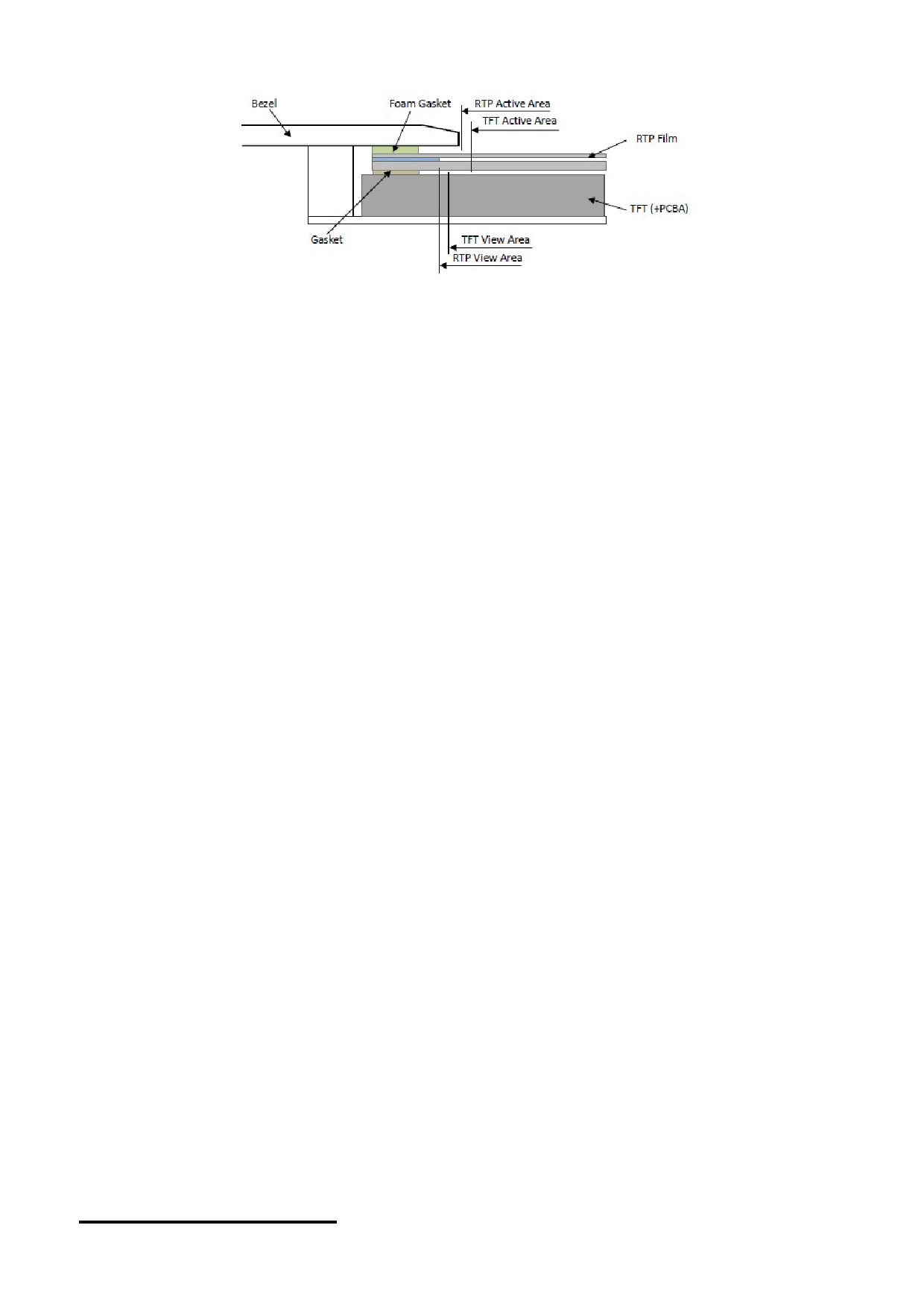
TOPWAY
LCD Module User Manual
LMT035KDH03-NHA-1
Figure 5
Warranty
This product has been manufactured to our company’s specifications as a part for use in your company’s general
electronic products. It is guaranteed to perform according to delivery specifications. For any other use apart from general
electronic equipment, we cannot take responsibility if the product is used in medical devices, nuclear power control
equipment, aerospace equipment, fire and security systems, or any other applications in which there is a direct risk to
human life and where extremely high levels of reliability are required. If the product is to be used in any of the above
applications, we will need to enter into a separate product liability agreement.
- We cannot accept responsibility for any defect, which may arise form additional manufacturing of the product
(including disassembly and reassembly), after product delivery.
- We cannot accept responsibility for any defect, which may arise after the application of strong external force to the
product.
- We cannot accept responsibility for any defect, which may arise due to the application of static electricity after the
product has passed our company’s acceptance inspection procedures.
- When the product is in CCFL models, CCFL service life and brightness will vary according to the performance of the
inverter used, leaks, etc. We cannot accept responsibility for product performance, reliability, or defect, which may
arise.
- We cannot accept responsibility for intellectual property of a third part, which may arise through the application of our
product to our assembly with exception to those issues relating directly to the structure or method of manufacturing of
our product.
URL: www.topwaydisplay.com
Document Name: LMT035KDH03-NHA-1-Manual-Rev0.1
www.topwaysz.com
Page: 17 of 15
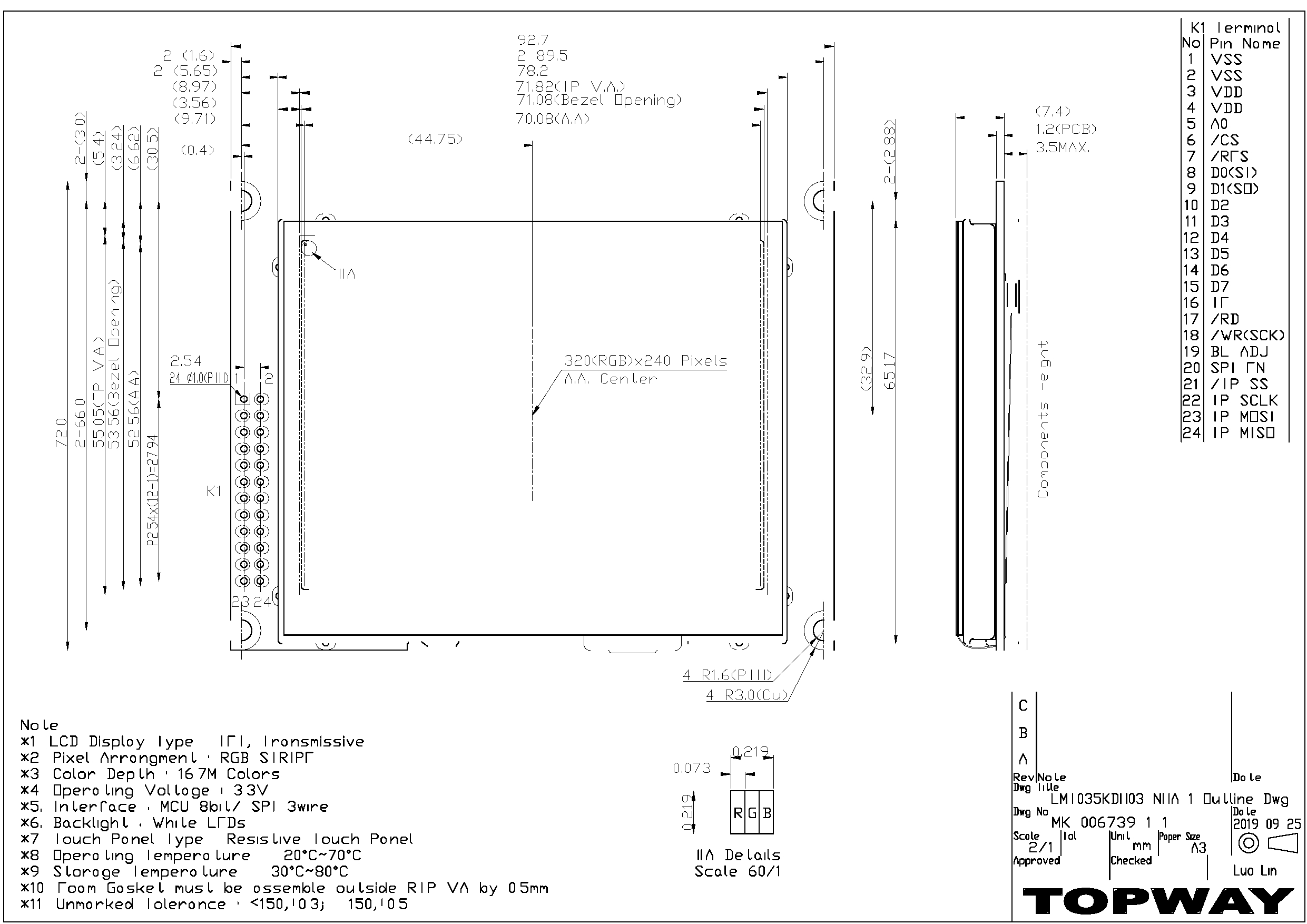
>